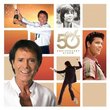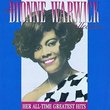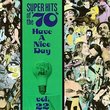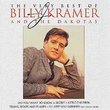| All Artists: Neil Sedaka Title: Show Goes On: The Very Best of Neil Sedaka Members Wishing: 4 Total Copies: 0 Label: Universal UK Release Date: 3/27/2006 Album Type: Import Genres: Pop, Rock, Broadway & Vocalists Styles: Easy Listening, Soft Rock, Oldies, Teen Pop, Vocal Pop, Oldies & Retro Number of Discs: 2 SwapaCD Credits: 2 UPC: 602498379516 |
Search - Neil Sedaka :: Show Goes On: The Very Best of Neil Sedaka
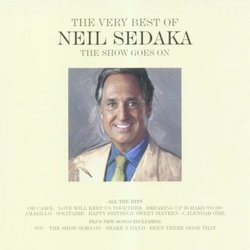 | Neil Sedaka Show Goes On: The Very Best of Neil Sedaka Genres: Pop, Rock, Broadway & Vocalists
|
Larger Image |
CD DetailsSimilar CDs
|
CD ReviewsSedaka's best release (NEW and old) in nearly three decades! R. Bourbeau | Maui, Hawaii, USA | 10/07/2006 (4 out of 5 stars) "It is indeed a privilege to be the first person to review Neil Sedaka's brand-new 2006 two-CD, 43-track release The Show Goes On: The Very Best of Neil Sedaka. It's also a tie-in to the concert DVD filmed April 7, 2006, at the Royal Albert Hall in London: The Show Goes On: The Very Best of Neil Sedaka - Live at the Royal Albert Hall (please read my review here at Amazon.com).
Being a U.K. import, it's important to note that Neil Sedaka is veritable American musical royalty to Britons and, that being said, THE SHOW GOES ON has been packaged with them specifically in mind. I say this because most Americans will not recognize a number of songs here from the '70s that were not even album cuts here in the U.S., let alone being released as singles. The irony is palpable in that Britain was the reason for his music's fade from popularity in America, when 1964 brought us The Beatles and the so-called British Invasion--and the end to Sedaka's "shooby-doos" and "sha-la-las." But at the same time, Sedaka packed himself, his wife Leba, daughter Dara, and son Marc and moved to Britain, where the English welcomed Sedaka with open arms with his early '70s albums "Emergence" (1971) and "Solitaire" (1972), produced by the guys who a few years later would be popular in the U.S. in their own right as the group "10cc," with the hits "I'm Not in Love" and "The Things We Do for Love." Meanwhile, as Elton John was becoming a major international star and developed his own recording label, Rocket Records (named after his hit "Rocket Man"), Sedaka's popularity and presence on British radio caught the attention of the bespectacled musician. Elton agreed to sign Neil to Rocket Records, and he released two more albums in the U.K., "Laughter in the Rain" (1974) and "Overnight Success" (1975), which are the sources from which some tracks on these CDs may not be familiar. And it is from "Solitaire" and "Laughter in the Rain" that the tracks were culled to create Sedaka's 1974 U.S. breakthrough comeback album, SEDAKA'S BACK. THE SHOW GOES ON features seven new recordings ("new" is relative, because they were actually recorded in 2003, but whatever!) and six new songs. I haven't been this excited about a release featuring new Sedaka compositions since his last major U.S. album release, 1979's "In the Pocket," which would yield his last U.S. Top 20 chart hit, the landmark 1980 duet with his daughter Dara, "Should've Never Let You Go," which is included here and still sounds as lovely now as it did then. But Dara has now matured into a 43-year-old woman in 2006 and is no longer the 17-year-old girl she was back then. She's got vocal chops all her own, and her cool and sassy duet with her dad on his groundbreaking song "Laughter in the Rain" is a vibrant and almost jazzy re-interpretation of his #1 solo hit from 1974-75, and you'll find both versions here too. The duo recorded a duet of "Laughter" in 1991 also, which was included on the 1995 CD TUNEWEAVER (please see my review here at Amazon.com), but her voice has gotten even better since then. All six of the new songs appear on Disc 1 and are simply outstanding. Sedaka has always worked best when he teams up with a compatible lyricist. First it was his teenage buddy and Brooklyn neighbor from the same apartment building, Howard Greenfield (who passed away in 1986), and then after he moved his family to Britain, with Phil Cody. Sedaka's own lyrics can often be pedantic and downright simplistic. But that is definitely not the case in THE SHOW GOES ON. Sedaka may be 67 years old in 2006, but his songwriting has turned utterly inspired and invigorated, and that especially pertains to the depth of his lyrics. My personal favorite of the new songs is his paean to Leba Strassberg Sedaka, his wife of nearly 45 years (and his manager), in "Lovely Leba." It's saucy, sexy, and has a contemporary groove. So has the totally funky "Been There, Done That," in which the dude is kicking his soon-to-be-ex out the door after reaching the end of his patience. The first single issued in the U.K. is also the first track on the album, which is "You," a lush and lovely ballad and love song. "Shake a Hand" is a plea for peace and civility and offers a gentle but undeniable rebuke of mothers having to learn the fates of their fallen soldier-sons in these times of sometimes illogical war. The title cut, "The Show Goes On," is an ode of regret about a musician hoping to find his woman who used to occupy a certain seat in the front row of every performance, but instead he looks to find that seat empty as he returns to his hotel room alone. And "I Fell in Love With a Dream" is somewhat reminiscent of a '40s big-band number but then morphs into a catchy, swaying, very danceable number. Counting the "Laughter in the Rain" cover, there is not even a mediocre new song in this set. They're all simply that good. For all the purists (aka late-'50s/early-'60s fans), most of the early hits are here: "Happy Birthday, Sweet Sixteen"; "Oh! Carol" (his tribute to then-girlfriend Carole King); "Next Door to an Angel"; "Calendar Girl"; "Stairway to Heaven" (and no, it's not the Led Zeppelin song, which came along far after Sedaka's and is an entirely different song, of course); "Little Devil"; the rarely-heard "One Way Ticket to the Blues," written by close Sedaka/Greenfield friends Jack Keller and Hank Hunter and also the only song in this 43-track selection not written or co-written by Neil Sedaka; and the standard-bearer for that early era, his #1 smash from 1962, the original version of "Breaking Up Is Hard to Do." Also included is Sedaka's first chart single from 1958, the silly and fun novelty tune "I Go Ape," while he has decided not to include any of the recordings made with the group he founded, The Tokens (who went on to score a big hit after he left the group with "The Lion Sleeps Tonight"). Also not appearing here are a number of songs that he wrote or co-wrote that went on to become hits for other artists, such as Connie Francis ("Stupid Cupid," "Where the Boys Are"); ABBA ("Ring, Ring"); and The Captain and Tennille ("You Never Done It Like That"), just to name a very few. One song I'm glad he included is "Run, Samson, Run," another novelty tune that relates the Bible story about Delilah getting her grips into the strong man, with the singer warning him not to let the lady clip his legendary tresses. And finally, some people may not know that Sedaka's original path began at the Juilliard School of Music as a classically-trained pianist. But when he and Greenfield began writing pop songs in the New York City legendary Tin Pan Alley's Brill Building, and then Neil began recording his own songs and became a pop star in his own right, his mother Eleanor became decidedly unhappy. Her dream was for her son to become the next Van Cliburn, not the latest rock-and-roll star on TV. In an effort to appease her, Sedaka wrote "You Mean Everything to Me," a ballad (a rarity for him at the time) in a minor key (virtually unheard of). Since Neil ended up doing all right, one might suppose that Eleanor eventually overlooked her initial displeasure. Moving into the '70s now, SEDAKA'S BACK (1974; please see my review here at Amazon.com) is very well represented. Since SEDAKA'S BACK was mostly a repackaging of songs from 1972's "Solitaire" and 1974's "Laughter in the Rain" (both U.K. releases), it did not take long for 1975's THE HUNGRY YEARS to come along, but I'll get to that in just a bit. Although the single "Laughter in the Rain" was released in late 1974, it took a long and leisurely pace up the charts and finally made it to #1 in early 1975. The other singles from this album were the Top 25 hit "The Immigrant," featuring the exquisitely beautiful and thought-provoking lyrics by Phil Cody, and "That's When the Music Takes Me," a Top 30 hit written solo by Sedaka that is now his usual standing-ovation curtain-call closer. The version included here was recorded live, in-concert. Other cuts from SEDAKA'S BACK include the biggest U.S. hit for all of 1975 and international smash, The Captain and Tennille's #1 cover of "Love Will Keep Us Together"; "Standing on the Inside"; "Sad Eyes"; and "The Other Side of Me." There is also "Our Last Song Together," which was what Sedaka and Greenfield believed to be their last collaboration as the two had a falling out and decided to stop writing together. Thankfully, though, it wasn't the end; they reunited and wrote together again before Greenfield's death in 1986. There is also one of his signature songs, "Solitaire," here provided as another live, in-concert version, but with utterly horrible audio. Using this particular version may not have been a particularly wise choice when compared to, say, the original U.K. version from 1972 that was also included on the 1974 album SEDAKA'S BACK. Sedaka never released "Solitaire" as a single himself, but when he and his family returned to the U.S. when his singles became hits stateside again, he began touring as the opening act for the sibling duo The Carpenters. Karen and Richard decided to record and release "Solitaire" as a single themselves; it became a Top 20 hit for them. "Solitaire," of course, has been given new life in the 21st century, thanks to Fox TV's "American Idol." In the 2003 season, Sedaka's music was featured one week, and he was also a guest judge (the guest-judge aspect of the series for the 12 finalists has since been dropped). Season runner-up (and now hearthrob and recording artist) Clay Aiken informed the audience that "Solitaire" had been one of his mother's very favorite songs, and she begged him to sing it that week. He did, and his performance literally brought Sedaka to tears, followed by Sedaka offering to produce an album for Aiken. Well, that didn't exactly happen, but Aiken did record "Solitaire" off-CD and added it as the B-side to his single "The Way," from his 2004 CD "The Measure of a Man." But "Solitaire" began to gain ground instead of "The Way," and when "Solitaire" was then issued as the A-side of the single, it promptly shot directly to #1 in sales, and Sedaka was once again #1 on the charts, albeit as a composer. Sedaka was invited back to "American Idol" several weeks later to celebrate the success of the single. THE HUNGRY YEARS (1975; please see my review here at Amazon.com) is arguably the most critically and commercially successful album of Sedaka's career. The title song, "The Hungry Years," although never released as a single by Sedaka, probably contains Greenfield's best lyrics ever, in which Sedaka wonders if the leaner, meaner years meant a whole lot more in the long run than the days of plenty now. Wayne Newton had a minor cover hit with the song. The big story from this album is Sedaka's most commercially successful song of his career, "Bad Blood," which spent three weeks at #1 and was certified gold. The rocker featured an uncredited duet with label mate Elton John. The followup was a slowed-down, bluesy version of his 1962 hit, "Breaking Up Is Hard to Do," and it remains today the only time an artist has hit the Top 10 with an entirely different version of the same song that had also previously hit the Top 10 (or, in this case, the original hit #1 and the second version hit the Top 10). The Captain and Tennille cashed in again with their Top 5 cover version of "Lonely Night (Angel Face)," with Sedaka's original version included here. And finally, there is also "New York City Blues," featuring more brilliant Phil Cody lyrics in which Neil chastises his hometown with all of its negative aspects but does so with love and compassion because it is, again, his hometown. STEPPIN' OUT (1976; please see my review here at Amazon.com) ends up being a curiosity here. The first two singles--the Top 20 dance/rocker "Love in the Shadows" and the Top 40 title-song rocker "Steppin' Out" (the second and final vocal collaboration with Elton John) are strangely missing from this collection. But the third single, which only managed to make the mid-charts in the U.S., is included here and is the bouncy and ever-optimistic "(You Gotta) Make Your Own Sunshine." STEPPIN' OUT was the third and final album made in the U.S. for Rocket Records. Sedaka then moved to Elektra. That first Elektra release was "A Song" (1977; out of issue), and the first single was a mid-charter in the U.S. for Sedaka called "Amarillo," referring to the north-Texas city in the panhandle. But the song was actually written in 1971 and recorded the same year in the U.K. by Tony Christie as "(Is This the Way to) Amarillo?" "...Amarillo?" was one of the biggest hits of Christie's career, and he would go on to record other Sedaka classics, including "Solitaire." In 2002, Christie released a retrospective album of greatest hits called "Worldhits and Love Songs," including "...Amarillo?" What a strange trip would start from here. Thereafter, "...Amarillo?" was used in a comedy skit on British TV, then it was used in a video for the British version of Comedy Relief called "Is This the Way to Armadillo?" By 2005, Christie had long since retired to Spain to golf, as Sedaka tells the story, but apparently the song had been re-released because of its use with all of the comedy bits. Christie and Sedaka ended up having the last laugh, though, as "(Is This the Way to) Amarillo?" spent seven weeks at #1 in its 2005 re-issue on the British charts. It didn't stop there, though. By changing the lyrics and adding a throbbing dance beat, the Brits were gearing up for their place in the upcoming quadrennial World Cup football--er, soccer--matches, and in 2006 the song was given still another new life as "Is This the Way to Win the World Cup?" And, if you order the companion DVD of NEIL SEDAKA: THE SHOW GOES ON, you'll see Sedaka being presented with an award for the most successful song in Britain in the 21st century (well, so far, at least) for "(Is This the Way to) Amarillo?" THE SHOW GOES ON also includes four tracks from his 1998 CD "Tales of Love," including two new (well, okay, "recent") songs and two re-recordings of earlier tracks. "When You're Gone" is a solid midtempo rocker that features the backing vocal of Will Lee, who's probably better known as the bass player in Paul Shaffer's band on CBS' "The Late Show With David Letterman." Although Lee plays bass on the entire CD, many will be surprised at what a powerful, solid singer he is, including in his falsetto voice. Shaffer and Letterman should let him sing solo! "Inseparable" is another catchy midtempo rocker with a solid hook that'll make you hear the song in your head all day long. It's a great song. The other two tracks are remakes and, unfortunately, are subpar compared to the originals. "I Let You Walk Away," from STEPPIN' OUT, is a plaintive rock ballad that featured a killer guitar solo in the original version. "Alone at Last," from "A Song," had a gorgeous bossa nova beat and instrumentation, plus an added track of waves washing along the shore to boot. Neither remake can come anywhere close to the quality of production of the originals. One can only assume that it's an attempt to boost the sales of "Tales of Love," but these two outstanding songs were so perfect in their initial presentations that these remake attempts are doing them a terrible disservice. Finally (I know this is long, but his career does span six decades, from the 1950s to the 2000s, so there's much to discuss!), there are the tracks that Americans may not know. "Going Nowhere" is a powerful song with melancholy but provocative lyrics by Cody and a beautiful melody from Sedaka; it's a gem of a find. "Rock and Roll Wedding Day" is a cute ditty about a couple getting married during the heyday of Elvis and the early rock idols (such as Sedaka, one must presume). "Queen of 1964" has an interesting history in that Sedaka had to actually record a "clean" radio edit! I don't know if you can imagine Neil Sedaka singing nasty lyrics, but the story is about an aging female rock groupie who can't let go of the past and still fancies herself as the youthful cutie who would wait by the stage door to get picked up the guys in the band (several of the big names are mentioned, along with the famous L.A. rock club The Troubadour). However, when it came to referring to The Rolling Stones, Sedaka had to record a second "clean" version that changed "She once 'had' Mick Jagger" to "She once 'kissed' Mick Jagger." It sounds almost quaint and downright laughable in these days of four-letter-word hip-hop and gangsta rap songs that those lyrics could possibly be offensive, but things (and perceptions) change in 30 years. And finally, I suppose one could imagine "Betty Grable" as Sedaka's version of Elton John's "Candle in the Wind," his tribute to Marilyn Monroe. Going to the movies is a recurring theme in many of Sedaka's songs, and "Grable" sings of a youth whose friends would go to see the latest in Disney cartoons, while he would be there to see his favorite pinup girl. I can't imagine "Grable" ever being re-imagined as a tribute to a fallen royal princess, as "Candle" was for Princess Diana, but it fulfills its purpose, and Grable did look great in a sweater. So that's it (finally!). Neil Sedaka's voice at age 67 in 2006 sounds almost exactly the same as did in 1958 and as it did in 1974. It is amazing at how well he has cared for his voice over the years. As I've stated in other reviews, as a professional pianist, vocalist, and composer, Neil Sedaka has been my biggest influence. But that doesn't mean he gets a free pass from me. When I feel let down, I've said so quite plainly. In watching the video of NEIL SEDAKA: THE SHOW GOES ON when the edited version was shown this summer on my local PBS channel as a pledge-night special, I carefully watched when the camera focused on his hands playing the piano. Yes, "Laughter in the Rain" is still played in the key of F, just as it was when he first wrote the song. Many singers have to transpose songs (usually lower) as they grow older, often from smoking, and they can't hit the high notes or hold onto certain notes on pitch. None of these things affect Neil Sedaka. His voice and his piano playing are still virtually flawless. He is an amazing man and an amazing talent. And despite the little complaints here and there, you will hear all of that amazing man's amazing talent in every note you hear on THE SHOW GOES ON: THE VERY BEST OF NEIL SEDAKA. This is a definitive retrospective of his career while including some truly great new material. If I could give it another half-star, it would be 4.5 stars. But since I can't, my rating is: RATING: **** (out of 5) -- 11 Oct 06 -- BOB BOURBEAU" |

 Track Listings (43) - Disc #1
Track Listings (43) - Disc #1